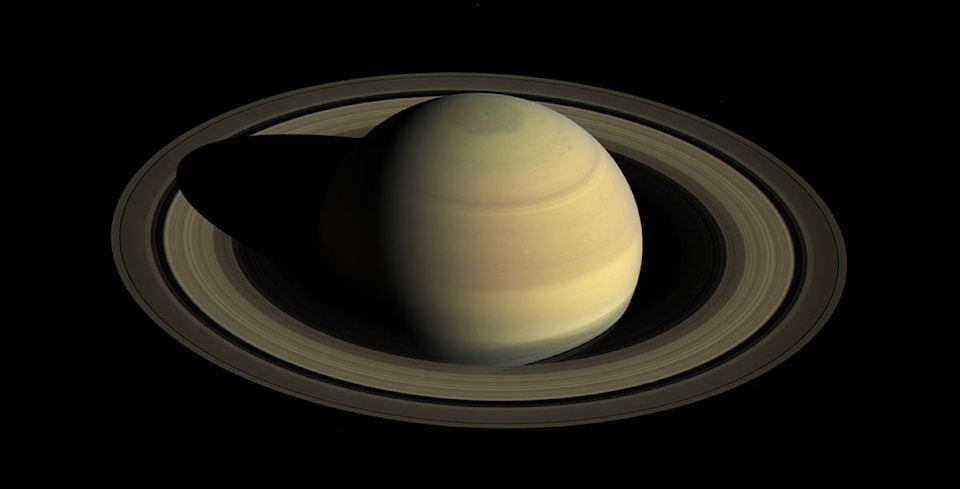By Samantha Bell
On Sept. 15 we say goodbye to Cassini as it ends its 293rd orbit of Saturn by plunging to a fiery death in the planet’s atmosphere. So ends a 13-year mission that was only planned to last four. This durable robot monitored seasonal changes at Saturn’s poles, tracked planet-encircling storms, measured structures in the ring system, discovered geysers and a subsurface ocean on Enceladus, and found methane-rich seas beneath the clouds of Titan (among other things).
Video from Cassini’s first dive between Saturn and its rings can be seen at www.nasa.gov, and it’s well worth watching the other short movies. Saturn was chosen as the final resting place for Cassini to prevent unwanted contamination of the moons Titan or Enceladus, which could potentially support life in the past, present, or future. Cassini will enter Saturn’s atmosphere at 119,100 km/hour (74,000 mph) with its thrusters constantly firing to keep the spacecraft antenna pointing towards Earth so it send us those last few data bits. It is extremely unlikely anything will be seen from Earth, but those in position to see it will probably watch anyway, just in case there is a tiny flash.
A moment of silence for the overachiever Cassini…
Okay, that’s good enough.
The Aurigid Meteors are active from Aug. 28 to Sept. 5 and peak Sept. 1, when this minor shower will reach six meteors per hour. There have been bursts of higher rates, but none are expected this year. The best view will be before dawn and after moon set, so let’s say 4 a.m. Look east-northeast in the constellation Auriga, which sits above the constellation Gemini. Still can’t find the radiant (where meteors appear to radiate from)? Find Venus, look up about 30 degrees and you will be in the general area.
The second half of September should be good for viewing the Zodiacal Light right before dawn. This cone-shaped glow appears over the eastern horizon and is caused by space dust. The moon will be out of the way, so just look around Venus.
Jupiter will spend September hanging low in the west-southwest during twilight, setting just under two hours after the sun at first and less than an hour after sunset by month’s end. You may want to look at the planet earlier in the month to minimize the blurriness caused by looking through more of the Earth’s atmosphere.
Sitting higher above the southern horizon after sunset is Saturn. This planet will set around 12:30 p.m. and set a half-hour earlier each week. Pointing a telescope towards Saturn in mid-month will reveal the rings tilted at 26.9 degrees to our line of sight. Even modest telescopes will reveal several of the planet’s many moons. Saturn will appear to have a soft yellow glow due to reflected sunlight and will appear within a hand of an orange-looking star called Antares, which is actually a red supergiant star.
Neptune will be visible all night starting in the southeast after darkness. On the evenings of Sept. 4 and 5, the full moon will appear close, making Neptune harder to see. Since this planet is opposite the sun with Earth in the middle, it is as its brightest in September. It will show up through binoculars as a blue-grey spot, or a a disk if you switch to a telescope.
Uranus will follow a couple hours behind Neptune, starting in the southeast in late evening, hovering in the constellation Pisces. It should be an easy binocular target and visible to the naked eye under a dark sky. Its blue-green colour is a dead giveaway.
Rising in the east two hours before dawn is Venus. It is nearly impossible to mistake Venus for anything else as it is the brightest thing in the sky, except for the sun and moon. On the mornings of Sept. 1 and 2, it will pass just south of the Beehive star cluster (M44), providing a nice binocular sight and great photo opportunity. On Sept. 1 it will travel into the constellation Leo, joining Mercury and Mars for the rest of the month, though it will be higher in the sky than the other rocky planets.
Mercury will reach its best morning appearance of the year on Sept. 12, when it stands above the eastern horizon about a half-hour before sunrise. With binoculars you should be able to spot Mars down and to the left of Mercury. At mid-month, Mercury will appear two-thirds lit if you look at it through a telescope. This planet will sink rapidly towards the horizon after Sept. 12, disappearing from view during the last week. Mercury should be at its brightest on Sept. 18.
Mars will rapidly climb higher in the east during over September, from the horizon to just below Venus. But before that happens it has to climb higher than Mercury. On Sept. 17, there will be a decent lineup of inner planets with the crescent moon at the top, followed by Venus, the the star Regulus (the brightest star in Leo), the further down Mercury, and finally Mars. On Sept. 18 the order will change to Venus at the top, Regulus, a very thin crescent moon, Mars, then Mercury. On Sept. 30, Mars will be very close to Venus. All three events would make good photos, weather permitting.
Did you know, the oldest rocks on Earth known to humans are located in the Nuvvuagittuq Greenstone Belt in Northern Quebec and were formed an estimated 4.28 billion years ago? Considering the Earth is estimated to be 4.5 billion years old, those rocks have been very lucky to survive this long. It makes you wonder what it was like back then. I wonder if some Canadian senators could tell us firsthand what it was like…
